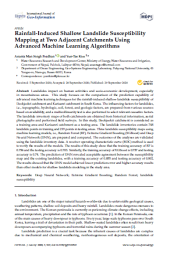Rainfall-induced shallow Landslide Susceptibility Mapping at Two Adjacent Catchments Using Advanced Machine Learning Algorithms
Summary
This case study is about the Landslide and its mapping induced by rainfall. Susceptibility mapping is a crucial tool to anticipate potential landslides in hilly regions. Hence, accurate prediction models are vital. Two neighboring watersheds were chosen to compare three machine learning models: RF, XGBoost, and DNN. Deokjeokri served as the training area and Karisanri as the testing area. Using GIS, a 748 landslide inventory in Deokjeokri and 219 landslides in Karisanri were created. With 14 thematic layers as factors, DNN outperformed XGBoost and RF models in accuracy, with DNN having 83.71%, XGBoost 74.73%, and RF 68.19%. Drainage proximity emerged as the most crucial factor. DNN proves promising for shallow landslide modeling. This enhanced mapping can aid spatial planning, mitigating landslide risk and bolstering environmental management in the region.
Categories:
Case Studies
Writer:
Ananta Man Singh Pradhan and Yun-Tae Kim
Link Source:
https://doi.org/10.3390/ijgi9100569
Publisher:
International Journal of Geo-Information
Published Year:
2020
